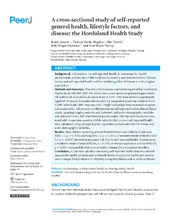| dc.description.abstract | Background. Information on self-reported health is important for health professionals, and the aim of this study was to examine associations between lifestyle factors and self-reported health and the mediating effect of disease in a Norwegian population. Methods andMaterials. The data collection was conducted as part of the Hordaland Health Study (HUSK) 1997–99, which was a cross-sectional epidemiological study. All individuals in Hordaland county born in 1953–1957 were invited to participate (aged 40–44 years). Complete information for the present study was obtained from 12,883 individuals (44% response rate). Height and weight were measured at a physical examination. Information on lifestyle factors, self-reported health, disease (heart attack, apoplexy, angina pectoris, and diabetes), and socio-demographic variables was obtained froma self-administered questionnaire. Self-reported health was measured with a one-item question. Odds ratios for fair or poor self-reported health were calculated using multiple logistic regression analyses adjusted for disease and socio-demographic variables. Results. Respondents reporting adverse lifestyle behaviours (obesity (odds ratio (OR) 1.7, p < 0.001), smoking (OR 1.2, p < 0.001), or excessive intake of alcohol (OR 3.3, p < 0.001)) showed an increased risk of poor self-reported health. Furthermore, a moderate intake of wine (OR 0.6, p < 0.001) or strenuous physical activity (OR 0.5, p < 0.001) decreased the risk of poor health.Disease did not mediate the effect. Conclusion. A one-item question measuring self-reported health may be a suitable measure for health professionals to identify levels of subjective health and reveal a need to target lifestyle factors in relatively young individuals with or without disease. | en_US |

